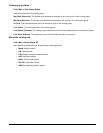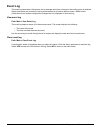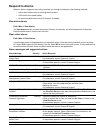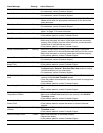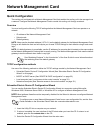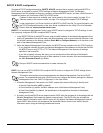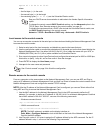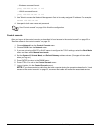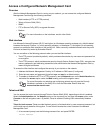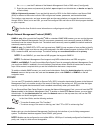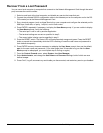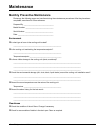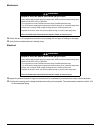
33InRow RC Operation and Maintenance Manual
Option 43 = 01 04 31 41 50 43
where
– the first byte (01) is the code
– the second byte (04) is the length
– the remaining bytes (31 41 50 43) are the Schneider Electric cookie
See your DHCP server documentation to add code to the Vendor Specific Information
option.
To change the control console DHCP Cookie Is setting, use the Advanced option in the
TCP/IP menu. See “Remote access to the control console” on page 33.
To disable the requirement that a DHCP offer include the Schneider Electric cookie, use
the DHCP Cookie Is setting in the control console:
Network > TCP/IP > Boot Mode > DHCP only > Advanced > DHCP Cookie Is.
Local access to the control console
You can use a computer connected to the serial port on the main board holding the Network Management Card
to access the control console.
1. Select a serial port at the local computer, and disable any service that uses that port.
2. Use the configuration cable to connect the selected port to the serial port on the main board holding the
Network Management Card. Use either 940-0103, the 6-ft (1.8-m) cable that came with your UPS, or
AP9804 (990-1524), the 15-ft (4.6-m) cable available from Schneider Electric.
3. Run a terminal program (such as HyperTerminal) and configure the selected port for 9600 or 19200 bps,
8 data bits, no parity, 1 stop bit, and no flow control. Save the changes.
4. Press ENTER to display the User Name prompt.
5. Use apc for the user name and password.
See “Control console” on page 34 to finish the configuration.
Remote access to the control console
From any computer on the same subnet as the Network Management Card, you can use ARP and Ping to
assign an IP address to a Network Management Card, and then use Telnet to access the control console of that
Network Management Card and configure the needed TCP/IP settings.
NOTE: After the IP address of the Network Management Card is configured, you can use Telnet without first
using ARP and Ping to access that Network Management Card.
1. Use the MAC address for the Network Management Card in the ARP command to define the IP
address. For example, to define an IP address of 156.205.14.141 for a Network Management Card that
has a MAC address of 00 c0 b7 63 9f 67, use one of the following commands:
– Windows command format:
arp -s 156.205.14.141 00-c0-b7-63-9f-67
– LINUX command format:
arp -s 156.205.14.141 00:c0:b7:63:9f:67
NOTE: The MAC address is available on the display interface at:
Path: Main > Configure Network
or look at the label on the back of the Network Management
Card for the MAC address.
2. Use Ping with a size of 113 bytes to assign the IP address defined by the ARP command. For the IP
address defined in step 1, use one of the following Ping commands:



